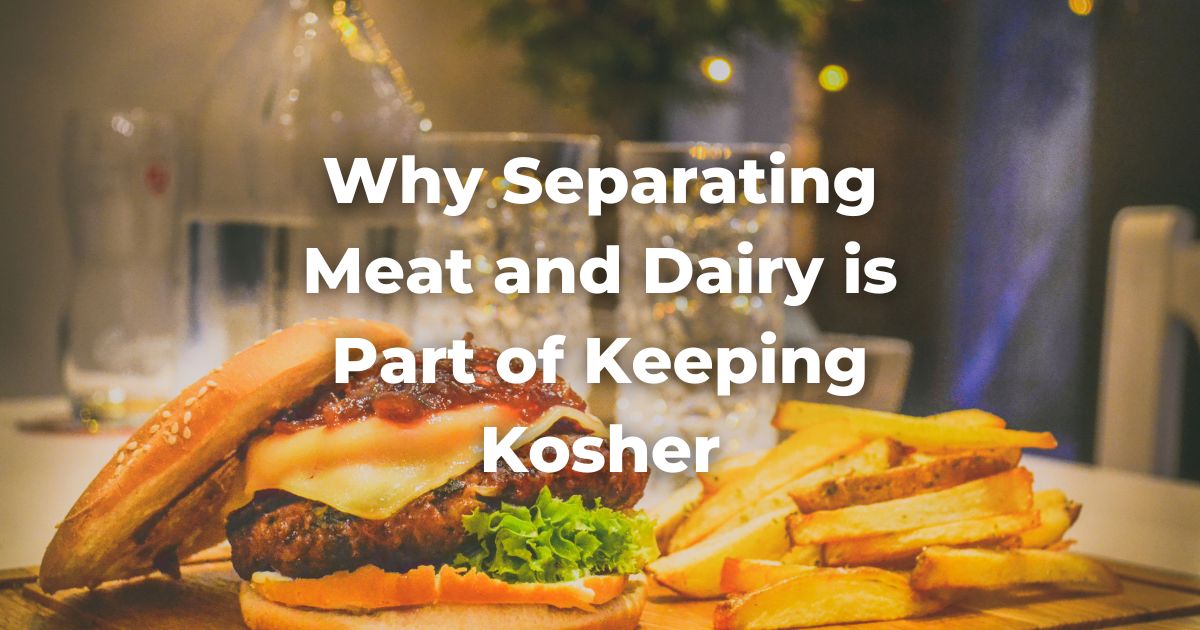Three times, at Exodus 23:19, Exodus 34:26, and Deuteronomy 14:21, Scripture ordains that one may not eat the flesh of a kid that has been cooked in its own mother’s milk.
The oral tradition connected with these verses vastly expands the concept to include three major areas of prohibition:
- dairy and meat products may be neither eaten
- nor cooked together,
- nor may one derive even ancillary benefit from such a forbidden mixture
(Mishneh TorahRefers to the first five books of the Hebrew Bible, the Tanakh, also called the Five Books of Moses, Pentateuch or the Hebrew equivalent, Humash. This is also called the Written Torah. The term may also refer to teachings that expound on Jewish tradition. Read more, Forbidden Foods 9:1).
There is no specific source in the Bible or the TalmudReferring to one of two collections, the Jerusalem and Babylonian Talmuds, edited in the 6th century, that contains hundreds of years of commentary, discussion, and exploration of the ideas in the Mishnah. One could describe it as Mishnah + Gemara = Talmud Read more that clearly states the reason for this supremely stringent policy of separating meat and dairy. However, there are many ideas have been suggested throughout the ages.
Maimonides, for example, writing in the Guide for the Perplexed (III 98), took a historical approach, writing that he imagined these laws to be a kind of reaction to the pagan custom of boiling a kid in its mother’s milk, which practice he imagined tied to pagan fertility rites.
More recently, however, Professor Edward L. Greenstein of Bar-Ilan University has taken a more anthropological approach, writing that the prohibition has symbolic meaning:
“Milk, which is meant to sustain life, may not be turned into a means of preparing an animal for eating. A clear distinction must be made between life, which is godly, and death. The post-biblical Jewish tradition underscores the distinction by broadening it: not only milk, but all dairy products and the utensils used for serving them must be kept apart from meat products and utensils” (Etz Hayim, p. 1461).
Whatever its rationale, however, the rabbis understood the law to apply to situations far beyond the literal meaning of the biblical verses.
The flesh of mammals and birds are both considered meat. Furthermore, even foods made with meat additives or meat by-products are considered meat in this context, even if there are no actual pieces of meat present.
Although, strictly speaking, clear consommés are in a different halakhic category than real meat, it is more or less universally the custom to consider clear soups made with meat bases to be meat with respect to these laws (see the gloss of the Rema to Shulchan Arukh, Yoreh Deah 89:3).
The flesh of fish, however, even “meaty fish,” is not considered meat.
Among many Jews of Ashkenazic descent, the Yiddish terms fleishig or fleishidik denote foods made of or with meat.
Foods made with milk or milk products are considered dairy. Milk, cream, cheeses, and butter are easily identifiable as being dairy.
Among Jews of Ashkenazic descent, the Yiddish terms milchig, milchidik, or milichdik denote dairy foods.
Of course, there are also many edible items or ingredients used in commercial food products that have their beginning in either meat or dairy foods, but which might not be obviously meat or dairy by the time they are brought to market.
In matters of doubt, a competent rabbi should be asked to determine the Kashrut status of food additives of various sorts.
The halakhah specifically forbids eating meat and milk products together.
But what exactly does this mean?
The basic prohibition has to do with putting both substances in the mouth at the same time and ingesting them simultaneously, but because meat leaves a residual taste in the mouth—and also as an extra step to ensure the separation of meat and dairy—the rabbis imposed a waiting period after eating meat before eating dairy.
How long exactly must one wait?
Customs vary and there is no one specific answer, but the most common customs are to wait between one hour and six hours.
The norm for most Conservative Jews is to wait three hours after eating meat before eating any dairy foods, this being a typical amount of time between meals in our society.
It is also necessary to wait an equal length of time after eating hard cheeses before eating meat products. (Hard cheeses are cheeses aged at least six months that cannot be sliced without falling apart or crumbling; parmesan is the best known of such cheeses.)
No such delay is required after eating other dairy products, such as cottage cheese, butter, ice cream, or soft cheeses, however (gloss of the Rema to Shulchan Arukh, Yoreh Deah 89:2).
One should, however, wash out one’s mouth after eating dairy foods before ingesting meat or meat products.
And though there is no technical reason forbidding it, it is customary not to serve dairy products as hors d’oeuvres before a meat meal.
Adapted with permission from The Observant Life.
Authors
-

Rabbi Paul S. Drazen (1951-2018) spent two-thirds of his rabbinic career serving individual congregations and one-third on the staff of USCJ, all the while creating programs and educational opportunities to make Jewish observance and practice clear, accessible, and attainable for everyone.
View all posts -

The Observant Life: The Wisdom of Conservative Judaism for Contemporary Jews distills a century of thoughtful inquiry into the most profound of all Jewish questions: how to suffuse life with timeless values, how to remain loyal to the covenant that binds the Jewish people and the God of Israel, and how to embrace the law while retaining an abiding sense of fidelity to one’s own moral path in life. Written in a multiplicity of voices inspired by a common vision, the authors of The Observant Life explain what it means in the ultimate sense to live a Jewish life, and to live it honestly, morally, and purposefully. The work is a comprehensive guide to life in the 21st Century. Chapters on Jewish rituals including prayer, holiday, life cycle events and Jewish ethics such as citizenship, slander, taxes, wills, the courts, the work place and so much more.
View all posts







